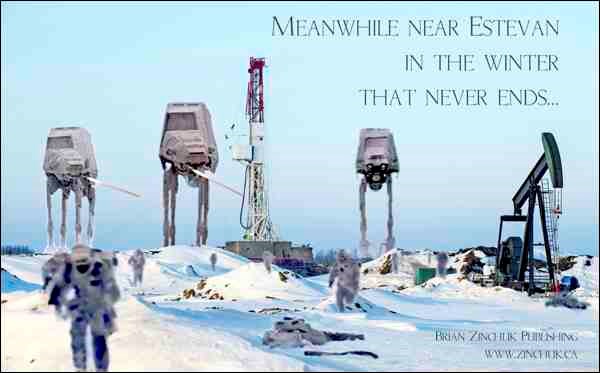Hindsight is 20/20, they say. So looking back several decades, the scientists agreed - if they had to pick a date when it all started, it was 2013.
Thirteen is aptly considered unlucky, for it was the year with no summer. Scratch that. It was the first year with no summer.
Moods were glum throughout Western Canada that spring. April showers were supposed to bring May flowers. Instead, all the precipitation would come as the "white stuff." Regina kept reporting another centimetre every few days. Roofs started collapsing. Brendenbury lost the roof of its rink. Still, these things can happen any given year.
But by the May long weekend, people really began to worry. There was still snow on the ground. No farmer could plant a crop. Half-million dollar tractor-and-air seeder combinations sat idle. Premiers called emergency cabinet sessions to deal with the crisis. Without a spring planting, for anyone, the economy wasn't just going to take a tailspin, it was going to crash and burn much worse than the 1930s. Farmers not seeding meant the base industry was in total collapse. While that was hard on the pocketbooks, it was worse for the stomach.
While much of the people's food was imported- vegetables from California, fruit from overseas, you couldn't truck in enough hay to feed the beef industry, nor grain to feed the pigs. With no hay crop that year, and a severe drought in the United States the previous year, there was no surplus to feed the animals. By July, three-year-old bales that were used for wind protection were fetching $200 a piece, if you could find them. By September, the beef herd had been culled by 75 per cent. There was no food, anywhere, to feed the cattle. After a brief time when stores couldn't give away all the recently slaughtered beef, and pork, North America suddenly found itself on a vegan diet, deprived of most of its milk, too. After all, you couldn't drink milk if you couldn't feed the cows.
World grain prices quadrupled over four months with the realization that there would be no grain production from the Canadian West, and substantially less from the American plains.
Natural gas prices also shot up, well beyond their 2007 peaks. With people running their furnaces year round, stockpiles dried up and, by fall, drilling resumed in earnest.
"Climate change," the people were told. "This is what happens when we drive gas-guzzling SUVs and burn coal. The world is getting warmer."
But it wasn't.
Statistical arguments can be made for anything, given enough numbers. For the past 30 years, climate scientists told anyone who would listen that the world was going to warm up. Sea levels would rise. Coastal populations would flee inland as massive cities the world over became inundated. But what they neglected to mention was that back in the 1970s, the same scientists had other concerns. Back then, they were concerned about another ice age coming.
What is an ice age? The math was simple, really. It snows more than it melts, and the snow stays year over year. Eventually it accumulates to form ice sheets. Over thousands of years, these ice sheets grow to be miles thick. Precious little can live on them, and nothing can live under them.
Yet this was the natural state for nearly all of Canada for roughly 80,000 of the past 100,000 years, and countless cycles before that. Mankind, for all of its recorded history from the time Abraham left Ur in Mesopotamia, had been living during the peak of the interglacial period. No one had written on clay tablets of the great ice age. So it was conveniently forgotten, even though the evidence of it was all around. Nearly every piece of land north of the 49th parallel around the world had been sculpted by those massive glaciers, everything from the hills to the rivers that flowed from them.
This time, the scientists could be more definitive. It started in 2013, when the snow stayed. The high reflectivity of snow prevented the ground's absorption of the sun's rays. The air is warmed by the ground radiating heat originally absorbed from the sun. The result was snow instead of rain.
Three years on, Canada was a shambles. Two thirds of the nation was out of work and on the run, almost all of them to the south. The rest were packing. The Americans welcomed them with open arms, at first. After all, if a million or so Mexicans came across the Rio Grande every year, surely they could absorb some Canucks. But they faced pressures too. With a shortened growing season, corn, one of the most caloric-intense foods on the planet, and the staple of the American diet, could no longer be grown. Millions would go hungry.
Of the Canadians who remained, they soon realized it was a losing battle. There's only so much snow you can push. You can only build a snowblower so big. All trains were equipped with massive snowblowers, the types that previously had been seen only in the mountains. A few years later, trains could no longer run. The snow and ice had accumulated to the point where a track was simply a blown-in tunnel in a 15-foot tall snow bank.
By 2020, 85 per cent of Canada was no longer inhabitable. The capital for those that remained was moved to Vancouver. Most provinces ceased to exist, their borders erased by the ice sheets.
The funny thing is, in the earlier years, popular culture was enthralled with zombie apocalypses. Too bad they never realized the simple snow flake was their undoing. Like a zombie, it, too, would never yield.
- Pipeline News editor Brian Zinchuk drives a gas-guzzling SUV and lives within six miles of two coal-fired power plants, yet he still has nearly two feet of snow in his front yard. He can be reached at brian.zinchuk@sasktel.net.



